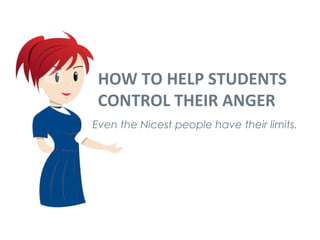
Help Educators Teach Students Anger Control
- 1. HOW TO HELP STUDENTS CONTROL THEIR ANGER Even the Nicest people have their limits.
- 2. HELP STUDENTS CONTROL THEIR ANGER Educators must help students realize that there are positive ways to cope, with and express anger appropriately and learn anger control strategies. The effects of abuse, neglect, homelessness, poverty, and ignorance exert a powerful effect on the emotional health and well-being of a growing number of students. For students with undiagnosed emotional/behavioral disabilities, angry outbursts may be triggered by seemingly non-existent causes.
- 3. TEACH SELF-ASSERTION AND ADVOCACY Students need to know what they need to succeed. Help students learn how to advocate for themselves.
- 4. SHARE POWER WHEN POSSIBLE Allow student input into how their school and classrooms are run. Allow students to participate in rule development and enforcement.
- 5. IDENTIFY PROBLEMS AND REINFORCE SUCCESS Identify and eliminate potential sources of anger or violence. Publicly and frequently reinforce positive behavioral and learning accomplishments.
- 6. USE EFFECTIVE LISTENING SKILLS Talk with students about their problems and attitudes toward a negative situation. Demonstrate sincere compassion and concern for your students.
- 7. MOVEMENT, BREAKS, AND MOTOR OUTLETS Allow movement breaks in your school and class schedule. Build motor outlets in the school or your class.
- 8. PROVIDE POSITIVE ALTERNATIVES Teach your students strategies that will limit, control, or divert angry impulses. Practice specific socially acceptable approaches to coping with anger.
- 9. TEACH PROBLEM-SOLVING STRATEGIES Teach students the steps of problem-solving: • Identify the problem • Brainstorm the solutions • Determine the best solution • Implement the solution • Evaluate the solution • Practice it in non-threatening situation
- 10. Failing to provide students, and in particular, those with behavioral/emotional disabilities, with appropriate strategies for coping with anger leaves them to select avenues such as physical aggression, verbal abuse, or threats as potential outlets.
- 11. HOW TO HELP STUDENTS CONTROL THEIR ANGER Created by www.practutor.com